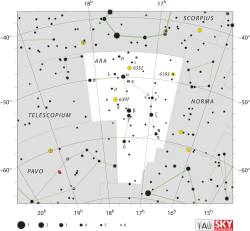Epsilon2 Arae (ε2 Arae, ε2 Ara) is the Bayer designation for a double star in the southern constellation of Ara. It is approximately 89 light-years (27 parsecs) distant from Earth. With an apparent visual magnitude of 5.3,[2] it is faintly visible to the naked eye.
| Observation data Epoch J2000 Equinox J2000 | |
|---|---|
| Constellation | Ara |
| Right ascension | 17h 03m 08.70964s[1] |
| Declination | –53° 14′ 13.3020″[1] |
| Apparent magnitude (V) | 5.29[2] (5.44/8.65)[3] |
| Characteristics | |
| Spectral type | F5 V Fe+0.5[4] |
| U−B color index | +0.015[5] |
| B−V color index | +0.48[2] |
| Astrometry | |
| Radial velocity (Rv) | +4.9[6] km/s |
| Proper motion (μ) | RA: +0.15[1] mas/yr Dec.: −165.20[1] mas/yr |
| Parallax (π) | 36.73 ± 0.63 mas[1] |
| Distance | 89 ± 2 ly (27.2 ± 0.5 pc) |
| Absolute magnitude (MV) | 3.27[7] |
| Details | |
| Surface gravity (log g) | 4.29[7] cgs |
| Temperature | 6,577[7] K |
| Metallicity [Fe/H] | +0.02[7] dex |
| Rotational velocity (v sin i) | 45.4[8] km/s |
| Age | 1.9[6] Gyr |
| Other designations | |
| Database references | |
| SIMBAD | data |
The brighter star is a magnitude 5.44 F-type main sequence star with a stellar classification of F5 V Fe+0.5.[4] The Fe+0.5 notation indicates that it has a somewhat higher than normal abundance of iron. It has a magnitude 8.65 companion at an angular separation of 0.590 arcseconds.[3] It has a common proper motion white dwarf companion, WDS J17031-5314, with a magnitude of 13.47.[9]
References
edit- ^ a b c d e van Leeuwen, F. (November 2007), "Validation of the new Hipparcos reduction", Astronomy and Astrophysics, 474 (2): 653–664, arXiv:0708.1752, Bibcode:2007A&A...474..653V, doi:10.1051/0004-6361:20078357, S2CID 18759600.
- ^ a b c Corben, P. M.; Stoy, R. H. (1968), "Photoelectric Magnitudes and Colours for Bright Southern Stars", Monthly Notes of the Astronomical Society of Southern Africa, 27: 11, Bibcode:1968MNSSA..27...11C.
- ^ a b Eggleton, P. P.; Tokovinin, A. A. (September 2008), "A catalogue of multiplicity among bright stellar systems", Monthly Notices of the Royal Astronomical Society, 389 (2): 869–879, arXiv:0806.2878, Bibcode:2008MNRAS.389..869E, doi:10.1111/j.1365-2966.2008.13596.x, S2CID 14878976.
- ^ a b Gray, R. O.; et al. (July 2006), "Contributions to the Nearby Stars (NStars) Project: Spectroscopy of Stars Earlier than M0 within 40 parsecs: The Northern Sample I", The Astronomical Journal, 132 (1): 161–170, arXiv:astro-ph/0603770, Bibcode:2006AJ....132..161G, doi:10.1086/504637, S2CID 119476992.
- ^ a b "* eps02 Ara". SIMBAD. Centre de données astronomiques de Strasbourg. Retrieved 2015-03-03.
- ^ a b Holmberg, J.; Nordström, B.; Andersen, J. (July 2009), "The Geneva-Copenhagen survey of the solar neighbourhood. III. Improved distances, ages, and kinematics", Astronomy and Astrophysics Supplement Series, 501 (3): 941–947, arXiv:0811.3982, Bibcode:2009A&A...501..941H, doi:10.1051/0004-6361/200811191, S2CID 118577511.
- ^ a b c d Balachandran, Suchitra (May 1, 1990), "Lithium depletion and rotation in main-sequence stars", Astrophysical Journal, Part 1, 354: 310–332, Bibcode:1990ApJ...354..310B, doi:10.1086/168691.
- ^ Schröder, C.; Reiners, Ansgar; Schmitt, Jürgen H. M. M. (January 2009), "Ca II HK emission in rapidly rotating stars. Evidence for an onset of the solar-type dynamo" (PDF), Astronomy and Astrophysics, 493 (3): 1099–1107, Bibcode:2009A&A...493.1099S, doi:10.1051/0004-6361:200810377[permanent dead link]
- ^ "GJ 2125 -- White Dwarf", SIMBAD Astronomical Database, Centre de Données astronomiques de Strasbourg, retrieved 2010-07-28.
